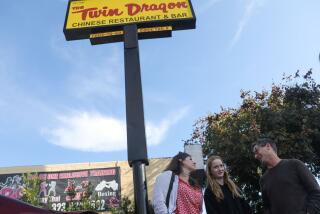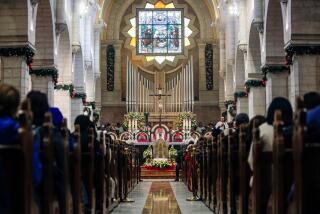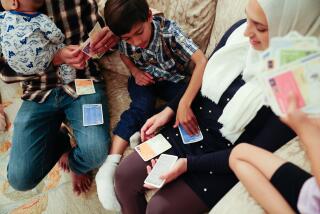Bethlehem, Pa.âs German Christmas tradition
Reporting from Bethlehem, Pa. â âIâd love to go to Germany for Christmas,â my mother often said when I was growing up, having visions of Kriss Kringle, the sparkle of candles on tannenbaum, carolers in the street and festive Christmas markets, all in a country where the season is celebrated with gusto. Though we were not a religious family, Christmas was important in our house, and yet we never went. As an adult, Iâve had the same hankering, with the same result. The anchor of family here is simply too good a reason to stay home.
Then I developed a more modest hankering â to spend a few Christmas-season days in Bethlehem, Pa.âs self-proclaimed âChristmas Cityâ â which my wife, Laurel, and I finally fulfilled last year.
The Hotel Bethlehem, amid the Moravian history of north Bethlehem, is a classic city âanchorâ hotel downtown, near everything and a destination in itself, so we headed there on a bright but chilly December afternoon. The hotel opened in 1922 at the behest of and with the support of Bethlehem Steel, whose blast furnaces, across the Lehigh River in south Bethlehem, are closed but once drove the cityâs economy.
The hotel lobby, lighted by late sun pouring through tall Palladian windows, was a Christmas fantasia: a handful of decorated trees, a crèche over the main entrance and evergreen swags draped from the balcony. Our bedroom looked down on Main Street, where storefronts glittered and the automobile traffic was salted with horse-drawn carriages.
On Christmas Eve in 1741, we learned later, in a cabin where the hotel now stands, Count Zinzendorf and other Moravian settlers from Saxony, Germany, dubbed their new home âBethlehem,â and the city was founded. This cabin is commemorated in a diorama visible to strollers passing by the hotel and also inside, in one of the seven George Gray paintings in the Mural Ballroom.
After checking in we headed for the Historic Bethlehem Visitor Center, a few doors from the hotel at 505 Main St., and signed up for a walking tour (a âChristmas City Strollâ) instead of the carriage or bus tours. On the 4 p.m. tour, we figured, dusk would fall and the lights of downtown blink on. Our docent, in a black hooded cape that might have cloaked a Bethlehem Moravian in the 18th century, walked and talked about how Moravian missionaries came to the area and how they lived.
Next to the hotel was a working blacksmith shop that dates from 1750 â operated, like the visitor center and tours, by the Historic Bethlehem Partnership â where a smithy toiled among the embers in the gloom of failing daylight.
âAn early settlement wanted three men,â he told us, âa blacksmith, a well-known minister and someone who could run a grist mill.â Outside again, we walked toward Church Street, where Main dead-ended into a handsome stone building with six-over-six windows that reflected afterglow. This was Brethrensâ House, the single menâs âchoirâ building. This introduced us to the choir system that prevailed in the early days, when the Moravians practiced a communal economy and men, women and children lived in segregated housing.
At the perfect, darkening hour, we passed the Central Moravian Church and the lovely buildings, wood, brick or stone, of Moravian College. In every window was a lighted candle (once beeswax, now electric), a tradition Moravians share with their neighbors, the Amish. On a hillside across the Lehigh the Bethlehem Star shone â now LED, not incandescent, a cause of some disgruntlement locally.
We had planned on dining at the hotelâs fine restaurant, 1741 on the Terrace, where we would have had views of brightly lighted Main Street, but it had been co-opted for a wedding, which also made the Tap Room (part of the lobby) frenetic. We settled for a drink there and walked to Edge Restaurant, stylish and just a block away, where pan-seared foie gras on toasted banana bread with a honey hazelnut drizzle was the highlight of our meal.
The next morning we headed to the church to see the putz, among the most cherished parts of a Moravian Christmas. Derived from the German putzen, âto decorate,â a putz is a crèche, generally under a Christmas tree. With music and narration, this one is more elaborate than most, featuring not just the Nativity but a series of scenes, each individually lighted as the story progresses. They are nestled on a vast carpet of live moss, gathered each November in the Pocono Mountains as a community exercise, and accented with wood and stones. Many of the figures are antiques brought from Germany.
Finally, we crossed Monocacy Creek to the Christkindlmarkt, a vast, tented cornucopia of shops featuring handmade goods, food stands of many ethnicities and entertainment, all in the festive German tradition that dates to the Middle Ages.
O Tannenbaum! We listened to carols, ate bratwurst, shopped. Weâll probably never get to Dortmund or Dresden for Christmas, but we were happy with this little slice of Germany in eastern Pennsylvania.
More to Read
Sign up for The Wild
Weâll help you find the best places to hike, bike and run, as well as the perfect silent spots for meditation and yoga.
You may occasionally receive promotional content from the Los Angeles Times.






